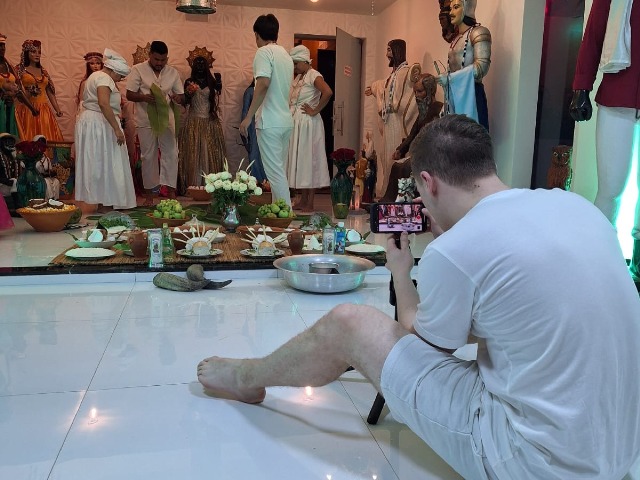Living ‘Lived Religion’ in an Afro-Brazilian Temple

I recognised the person standing in front of me. But the voice that spoke was not his.
“Acenda uma vela para o seu guia.”
Light a candle for your guide.
When a person was incorporated by a spirit, the change in their body was quite clear. In this case, the spiritual leader of the temple, the Babalorixá, stood in front of me, but it was Capa Preta speaking. Capa Preta was an Exu spirit whose name meant Black Cape.
The dark room was immersed in thick smoke from his cigar, which caught the blue, red, and green beams of light shining down from the ceiling. He asked me to light a candle for my spiritual guide, speaking in a deep, gravelly voice. This was one of my first direct instructions inside the terreiro, a small but meaningful step toward beginning my relationship with the spirits and understanding how this world of Afro-Brazilian religions worked.
Kneeling before the statue of Pena Branca, a caboclo spirit of Indigenous origin to whom I had been directed, a member of the temple guided me through the rituals of prayer and devotion. The statue itself, like most of the others around it, was life-size. He was a Black figure with a large Indian headdress.
I stood up and looked around at the other statues, perhaps twenty or twenty-five in total. A few smaller statues shared the space, including an old man and an old woman, each dressed in white, and several statues of children, including one holding an outstretched mirror, looking at their reflection.
Around them were various other Exus, the male spirits, and Pombajiras, the female spirits, as well as statues of the Orixás, the gods. These included Iemanjá, the goddess of the sea, shown as a slender figure in a long blue dress with a headdress topped by a yellow star. Next to her was a statue of Oxum, a Black figure wearing a yellow dress with her hand outstretched. Candles and offerings decorated their feet. A statue of Oxalá stood beside her. He was a more familiar figure, represented by a statue of Jesus Christ, arms outstretched, wearing a white tunic. It was an unusual figure, one that felt familiar to me but also carried the weight of the darker, colonial past of Afro-Brazilian syncretism and enforced Catholicism.
I lived in this temple for three months while working on the first chapter of my PhD on Buddhism. My desk was quite unusual. People in the temple often commented that they would not feel comfortable working for so long in a space with so much spiritual energy. I sat in an area known as the left side of the religion, in a room adjacent to the statues. This was the side that worked with Quimbanda and ritual magic.
The room was filled with spiritual artefacts on every surface. On top of the table sat a tray holding tarot cards and cowrie shells, surrounded by intricate statues of African and Indian figures, such as owls, goats, and spirits. Also on the table were several Orixás, represented by plates decorated with shells, stacked into detailed patterns.
Opposite the table was an altar. This was where spirits of light operated within darker forces, spirits believed to stay with you constantly. The altar stretched for about three metres and was completely black. A mix of items covered the space, including daggers, an obsidian black mirror, and other portals dedicated to different deities. Around them were offerings like candles, fruit, alcohol, perfumes, and whatever else had been left for the spirits.
At the centre was an imposing statue of Beelzebub, half man, half goat, with wings stretched out behind him. The figure also had breasts, a symbol of duality. One hand pointed upwards towards the ceiling, two fingers raised. The other pointed towards the floor. Smaller silver statues surrounded him, including Lilith, Lucifer, and others.
Beneath the altar, hidden under a permanent covering, was a kind of spiritual cemetery filled with bones, goat heads, and animal hearts. This particular temple worked with a wide range of spiritual forces. While it was the kind of thing that can be hard to swallow in the West, these figures were not constructed in the same way as the Christian devil.
Each week, the community gathered for their spiritual work and practice. Before stepping into the sacred space, everyone would shower and change into clean clothes, usually white or sometimes red and white. The environment was cleaned continuously, including each of the statues and their clothes, as well as the space itself. New guias, or spiritual beads, would be made for different people and events. I got a sense that the religion required a lot of manual labour, and that this was often shared amongst the community.
When I was not writing, I spent time joining ceremonies, helping out, and slowly learning how everything worked. I also helped with day-to-day tasks, such as offering water to clients waiting for consultations with the Babalorixá and serving coffee to those who came seeking advice about love, money, or health. It also included butchering Portuguese. Before ceremonies, I would help some participants with their clothing. This included carefully tying the enormous, beautifully layered cigana (gypsy woman) dresses to make sure they were comfortable and ready.
With the community’s permission, I filmed parts of daily temple life and recorded certain rituals. The community rarely had their practices documented, and many were genuinely excited to be able to capture these moments.
At times, religion is actually quite mundane. On a particularly hot day, I went to the local Lider supermarket to buy ice creams for members of the temple who had been cleaning.
I also had the opportunity to take part in some celebrations, including at a larger temple in another area. One evening, I attended a music event honouring Zé Pelintra, a spirit deeply connected to samba, a well-known Brazilian musical genre. Thousands gathered to sing, dance, and drum late into the night, getting particularly drunk in the process.
The first ritual I witnessed came as a shock. It was a spiritual embodiment ceremony in the Umbanda tradition. Nothing like the quiet Buddhist meditations or formal Christian masses I had observed before. As the ritual began, some people laughed and others screamed as their bodies became vessels for the spirits. You could see the change take hold. Their eyes glazed over. Their voices shifted. Their bodies trembled or convulsed. People I had only known as soft-spoken transformed completely. They laughed, blessed, embraced others, performed cleansings, and acted in ways utterly unlike themselves just moments earlier.
I witnessed several ceremonies like this during my time at the temple. I also observed animal sacrifice, including two white pigeons offered to the gods as part of an initiation ritual. After this ceremony, the community blessed me with my own spiritual necklaces in the colours that represented my own spiritual protectors, which were light blue and white, gold, and brown. I had multiple audiences with the spirits myself, and I was allowed to sit with the incorporated spiritual medium while other people had private meetings and sought answers or advice.
Whether or not spirit possession can be proven is beside the point. What was undeniable was the sense of presence within the person. The feeling that something or someone had arrived. The religion and the practices were real to the people practising them, and this practice made a positive difference in their lives. After being incorporated, people often had little or no memory of what had happened.
This temple wasn’t part of my fieldwork, but it shaped how I came to understand this religious landscape. I didn’t come to the terreiro as an observer, I lived there. I made friends. I also ate meals, cleaned the space, helped prepare for ceremonies, tied dresses, lit candles, and sat with the spirits like everyone else. I realised that, sometimes, understanding religion comes from being right in the middle of it and being part of the community.
About the author

Nathan Harrison-Clarke is a PhD Researcher at the University of Nottingham, School of Sociology and Social Policy. His focus lies in contemporary lived religion and its intersection with sexuality and gender. His PhD research delves into the lived realities of LGBTQ+ Buddhists in Britain. From September to December 2024, he served as a research and teaching assistant at the Centre for Religion, Conflict, and Globalization at the University of Groningen.

